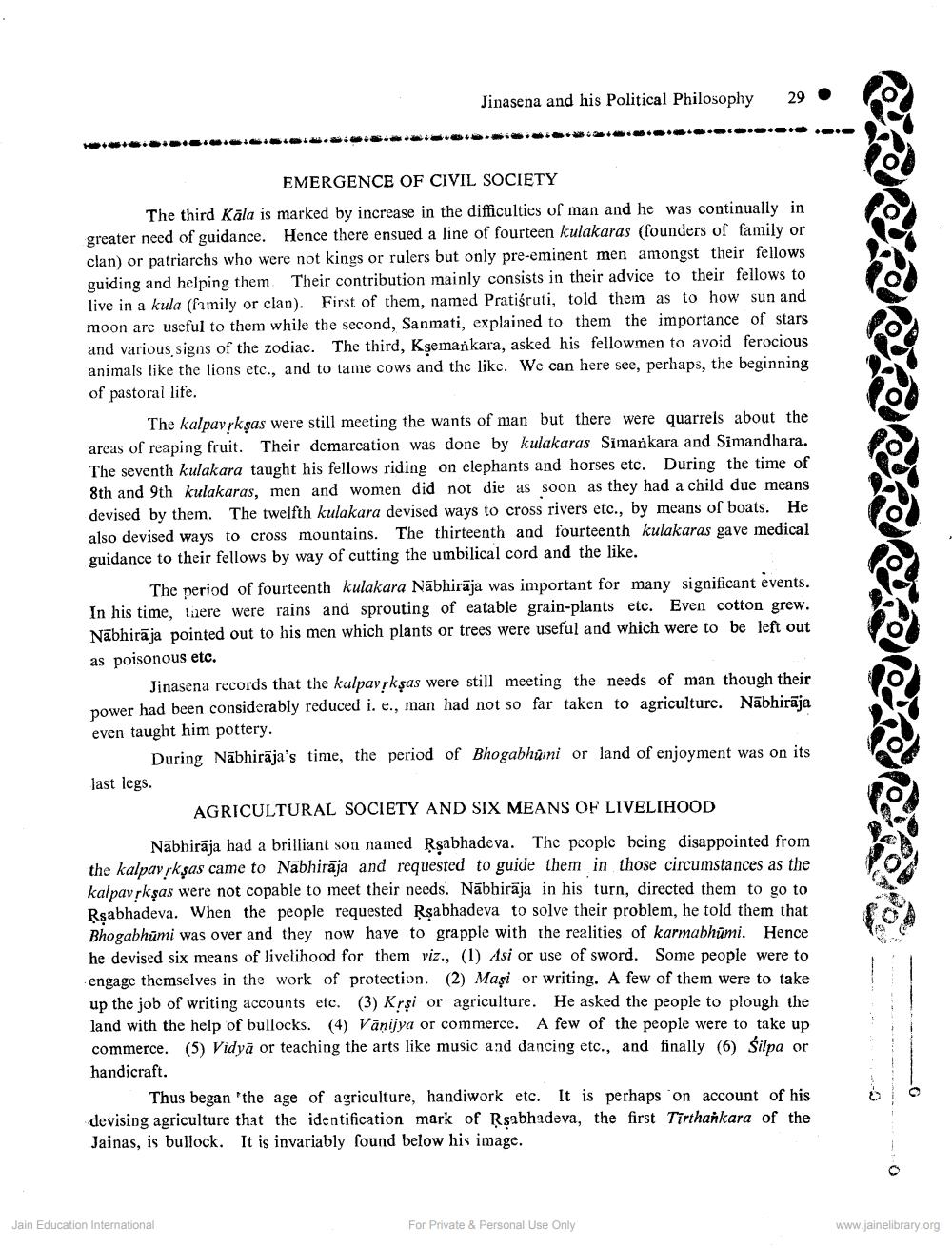________________
Jinasena and his Political Philosophy 29
EMERGENCE OF CIVIL SOCIETY
The third Kāla is marked by increase in the difficulties of man and he was continually in greater need of guidance. Hence there ensued a line of fourteen kulakaras (founders of family or clan) or patriarchs who were not kings or rulers but only pre-eminent men amongst their fellows guiding and helping them. Their contribution mainly consists in their advice to their fellows to live in a kula (family or clan). First of them, named Pratiśruti, told them as to how sun and moon are useful to them while the second, Sanmati, explained to them the importance of stars and various signs of the zodiac. The third, Kṣemankara, asked his fellowmen to avoid ferocious animals like the lions etc., and to tame cows and the like. We can here see, perhaps, the beginning of pastoral life.
The kalpavyksas were still meeting the wants of man but there were quarrels about the areas of reaping fruit. Their demarcation was done by kulakaras Simankara and Simandhara. The seventh kulakara taught his fellows riding on elephants and horses etc. During the time of 8th and 9th kulakaras, men and women did not die as soon as they had a child due means devised by them. The twelfth kulakara devised ways to cross rivers etc., by means of boats. He also devised ways to cross mountains. The thirteenth and fourteenth kulakaras gave medical guidance to their fellows by way of cutting the umbilical cord and the like.
The period of fourteenth kulakara Nabhiraja was important for many significant events. In his time, there were rains and sprouting of eatable grain-plants etc. Even cotton grew. Nabhiraja pointed out to his men which plants or trees were useful and which were to be left out as poisonous etc.
Jinasena records that the kulpavṛksas were still meeting the needs of man though their power had been considerably reduced i. e., man had not so far taken to agriculture. Nābhiraja even taught him pottery.
During Nabhiraja's time, the period of Bhogabham or land of enjoyment was on its last legs.
AGRICULTURAL SOCIETY AND SIX MEANS OF LIVELIHOOD
Nabhiraja had a brilliant son named Rsabhadeva. The people being disappointed from the kalpavrksas came to Nabhiraja and requested to guide them in those circumstances as the kalpavṛksas were not copable to meet their needs. Nabhiraja in his turn, directed them to go to Rsabhadeva. When the people requested Rgabhadeva to solve their problem, he told them that Bhogabhumi was over and they now have to grapple with the realities of karmabhumi. Hence he devised six means of livelihood for them viz., (1) Asi or use of sword. Some people were to engage themselves in the work of protection. (2) Maşi or writing. A few of them were to take up the job of writing accounts etc. (3) Krşi or agriculture. He asked the people to plough the land with the help of bullocks. (4) Vanijya or commerce. A few of the people were to take up commerce. (5) Vidya or teaching the arts like music and dancing etc., and finally (6) Śilpa or
handicraft.
Thus began 'the age of agriculture, handiwork etc. It is perhaps on account of his devising agriculture that the identification mark of Rṣabhadeva, the first Tirthankara of the Jainas, is bullock. It is invariably found below his image.
Jain Education International
For Private & Personal Use Only
0
www.jainelibrary.org




